- Introduction
-

Introduction
ADEBUNMI GBADEBO: This object was made by force.
VINCENT BROWN: I don’t think that we have spent enough time thinking about what art is when it’s the product of coercion.
GEORGE CALFAS: We believe that slavery was that for agriculture and cotton and tobacco; pottery in South Carolina really shows a different history.
NARRATOR: During the 19th century, hundreds of enslaved people labored in the potteries of Old Edgefield District, South Carolina. Around you are the products of that involuntary labor – the works of Edgefield’s potters.
DAVID MACK: It really was quite an industrial operation.
NARRATOR: But within that industrial stoneware operation, potters were producing extraordinary works of art.
GLENN LIGON: There is somehow the idea that artistic agency is antithetical to enslavement. But if you look at these objects, you’ll see that that is not the case.
NARRATOR: Welcome to the Audio Guide for Hear Me Now: the Black Potters of Old Edgefield, South Carolina. For this tour, we’ve invited artists, historians, potters, and an archeologist to consider the work of the enslaved potters of Edgefield within the context of a brutal system of repression.
TONYA MATTHEWS: When we don’t interrogate enslaved artisans in the same way we interrogate all of our other artisans and craftspeople, we lose a very, very big part of the story. Not just the story then, but the story that we’re living now.
NARRATOR: Please stay with us for a closer look and to hear how these works testify to the lived experiences, creativity, and material knowledge of enslaved peoples.
- Concatination
-

Storage Jar, 1834 (“Concatination”)
NARRATOR: This jar was made by an enslaved man named Dave. Vincent Brown, Charles Warren Professor of American History and Professor of African and African American Studies at Harvard University.
VINCENT BROWN: He signed his pottery ‘Dave.’ Simply Dave, and was known as Dave Pottery or Dave the potter. He took a surname Drake, after emancipation.
The fact that he's literate in a society where it's illegal for the enslaved to learn how to read, There's a boldness in making these inscriptions. He's kind of marking out a status for himself as someone who can commit a crime by writing, and not be punished for it.
NARRATOR: On this jar, Dave has written a single word: “Concatenation,” and the date. This is the earliest verse that we know of in Dave’s hand.
VINCENT BROWN: Concatenation, a series of interconnected things or events. The date, I think, is important there because it’s June 12th, 1834. Slavery was abolished in the British Empire on August 1st, 1834. So emancipation is coming, right? It’s not coming to the United States for another three decades, but I like to think that news was traveling about the coming of British emancipation in the Caribbean.
Nat Turner’s revolt had occurred just a couple of years earlier in Virginia, and that could be bound up in Dave’s sense of the coming of a great change. Of course, we can’t know; we can only speculate. But I think that the speculation takes us into the world of Dave.
NARRATOR: Dave’s fondness for words with many syllables, like “concatenation,” brought him a certain measure of notoriety.
VINCENT BROWN: The first reference to Dave that I think we know of is in the Edgefield Advertiser, where Dave describes how much he likes buttermilk.
NARRATOR: The word he uses to describe buttermilk? “Magnanimous.”
VINCENT BROWN: Dave is described as, “That grandiloquent old darkie.” He’s a local celebrity, but he’s a mascot. I think that that often still works out in advertisements and endorsements, where people who may be stigmatized because they’re from poorer communities, and often from Black communities, are maybe celebrated for something like athletic skill, and they wind up being mascots for things like shoes. Or for Wheaties (Laughs). And also suggests that we need to always be considering not only the talent, but also the social predicament of these artisans that we’re looking at here.
- Meat
-

A very Large Jar...
NARRATOR: Dave wrote on this piece: “A very Large Jar which has 4 handles / pack it full of fresh meats — then light candles.” Dr. Tonya Matthews, President and CEO of the International African American Museum.
TONYA MATTHEWS: You gotta read the poetry, right? I think we’re so fascinated by an enslaved man writing on a pot at a time when he wasn't supposed to read and write, that we don’t always take the time to interrogate the poem, the way we do with any other artist.
NARRATOR: In an era before refrigeration, this jar’s purpose was to store a large quantity of pork or beef, to be doled out in rations to people enslaved on plantations.
Dave’s artistry was itself an act of resistance. The verses on the vessels, like the two lines here, were simple, though layered with meaning. Dave's skill and talent as a writer was widely known and may have facilitated the illicit spread of literacy amongst the larger enslaved community.
TONYA MATTHEWS: Centering David Drake as just the enslaved artisan who wrote his name and poetry on a pot is akin to centering Van Gogh as the artist who just cut off his ear — it’s not that those statements aren’t true; it’s that those statements aren’t whole. It’s not just that he makes this beautiful work; but perhaps the work had to be that beautiful in order for him to live.
- 1857
-

I wonder where is all my relation
VINCENT BROWN: He says: “I wonder where is all my relation. Friendship to all and every nation.”
NARRATOR: On this jar, Dave has written this couplet that speaks to the profound dislocation of families under slavery.
Vincent Brown, Charles Warren Professor of American History and Professor of African and African American Studies at Harvard University.
VINCENT BROWN: I think a little background on that is important to know. The transatlantic slave trade ended in North America in 1808. But down to the Civil War, nearly a million people were sold from the older slave states; places like Virginia and South Carolina, to the new expanding slave states of Alabama and Mississippi. Families torn apart, children sold away, people dying along the trail, right? In just several decades. So you’re talking about massive, massive domestic slave trade that’s inordinately tragic.
Dave is living during that moment. His family, his partner and children, have been sold away. So the fact that he was a noted potter, a person who was highly valued for his skills, couldn’t save his family, that his family was torn apart by slavery, and it’s recognized in the work itself.
- 1859
-
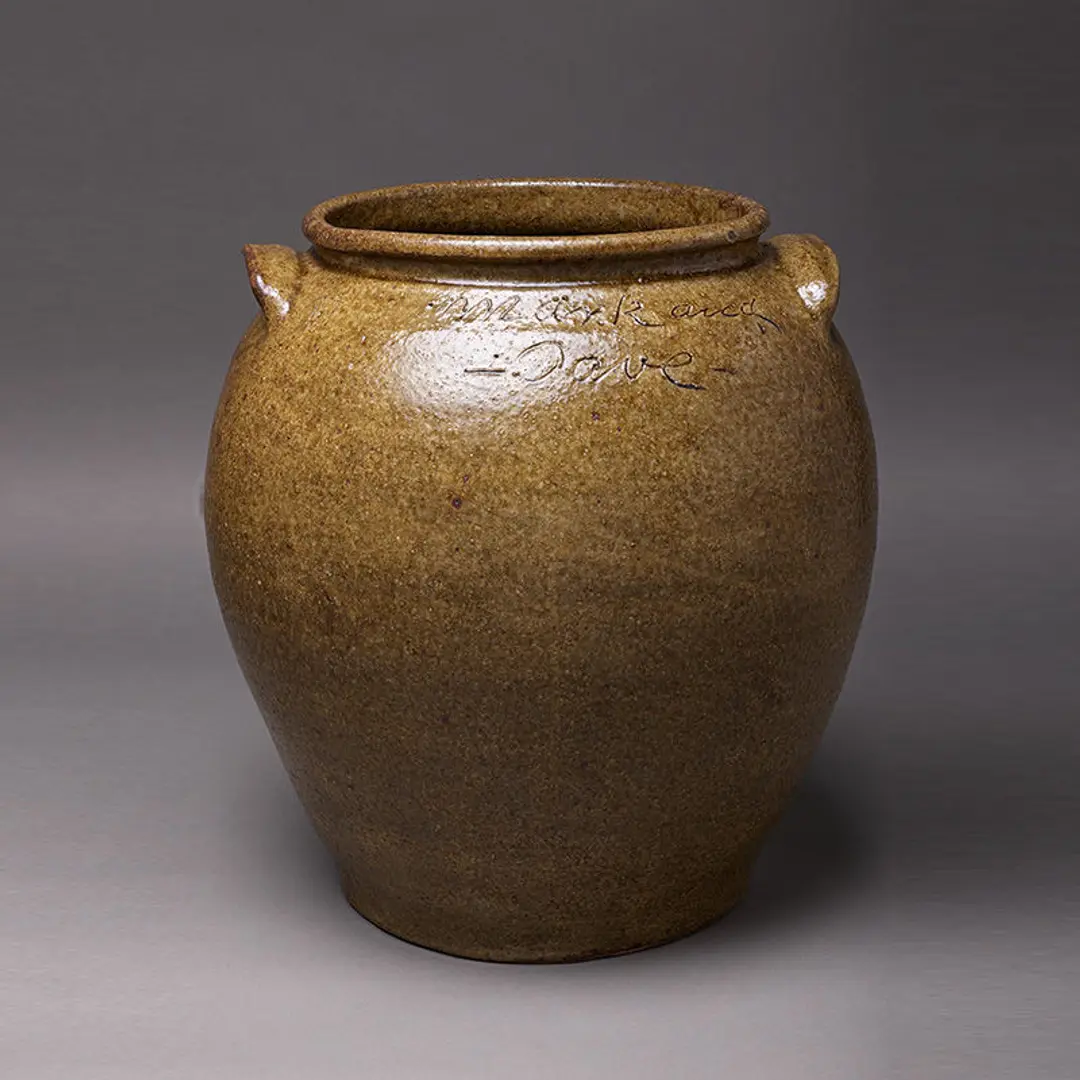
Storage Jar, 1859 (“Mark and Dave”)
DAVID MACK: There’s a lot of controversy out there that David Drake became intoxicated, fell across a railroad track, and a train severed his leg. I just cannot conceive of that happening, knowing what we know about torture and slavery in America.
NARRATOR: This jar bears the names of two Edgefield potters: Dave and Mark. Potter David Mack thinks he knows why.
DAVID MACK: I understand he had an apprentice, and I would probably assume that this is the guy who took up the slack in terms of kicking the wheel. You had, this big stone slab on the bottom of a kick wheel, and that’s what you had to kick, and I’m sure, if that leg or foot was amputated, then he would need some help. Of course, you could use the other leg, but I’m thinking that Mark was the guy.
NARRATION: Mark, who was later identified with the last name Jones and was living with Dave in 1870, could have helped in other ways.
DAVID MACK: You would need a table to roll out the coils, and Mark would give Dave the coils. It would have been thrown maybe halfway and then coiled up to the top. And then as the wheel goes around, you’re blending those coils in with the body of the clay.
NARRATION: You can see where the coils were added. Then, Dave had to smooth the heavy, wet clay, pulling up the walls of the pot.
DAVID MACK: Dave had a lot of upper body strength. Pottery is all about leverage, and it doesn’t necessarily mean that you have to be strong to pull up a big pot. It helps. It’s certainly an advantage. And it takes not just your hands, but it takes your entire body. It takes your back. It takes your legs. You’re talking about 40 pounds of clay. That’s a lot of weight.
NARRATOR: Mack has befriended some of the descendants of enslaved Edgefield potters, including a large extended family whose ancestors include Jones and Drake. The descendant families have not benefited from the increasing value of Dave’s work.
Mack has proposed a reparations bill, through which the family would receive a percentage of the sales price at auction.
DAVID MACK: I have personally written to politicians at the highest level, including our President and Vice President, senators and congressmen who have supported reparations. So, we think that there’s a certainly justified cause to have these reparations enacted.
- Names
-

Names
This stop includes the voices of artists, scholars, and community organizers, convened by the Museum of Fine Arts, Boston’s Table of Voices program during their presentation of Hear Me Now, reciting the names of a small portion of the many enslaved potters who never had the chance to inscribe their names in clay.
- Pork-and-Beef
-
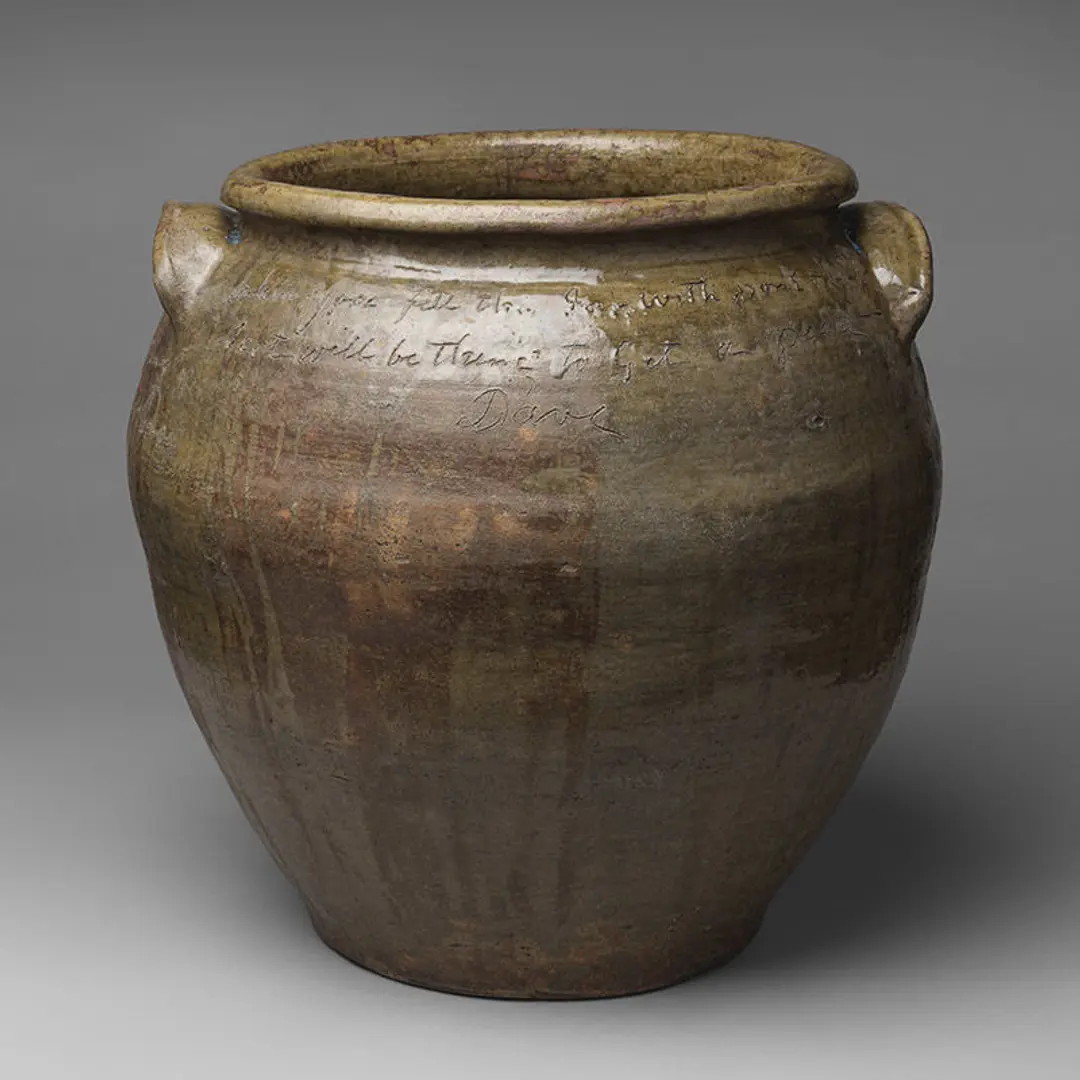
When you fill this jar with pork or beef…
NARRATOR: This storage jar was acquired by the Metropolitan Museum of Art in 2020. Artist Glenn Ligon.
GLENN LIGON: I have a seven-year-old godson who lives in Tokyo with his parents, and they were walking by an antique store in their neighborhood and they saw two jars. The owner thought that they were actually Dave Drake. That became a kind of fascination for them, how those ended up in Tokyo. So we made a pilgrimage to see the jar in The Met’s collection. And was actually surprised at the size of it. It has a physical presence that seems much larger than its stated dimensions.
NARRATOR: The inscription tells us what the jar was for — and for whom. It reads…
GLENN LIGON: “When you fill this jar with pork or beef, Scot will be there to get a peace.” It could be misspelling or a pun; if it is a pun, it’s a quite funny one because after you eat, you’re kind of sated, at peace, you know? (Laughs)
NARRATOR: The jar is further inscribed to a Mr. Segler and a Mr. Bacon.
GLENN LIGON: I’m assuming that Mr. Segler and Mr. Bacon are people that he takes orders from. There is something really interesting to me about how casually he addresses them. It's hard to imagine how an enslaved man could even write these words. But there they are, and we’re still puzzling over them.
NARRATOR: Ligon has lent a jug to this exhibition. The jug, covered in flowing, high-contrast glaze is located nearby.
GLENN LIGON: Dave could have just made ordinary jugs. But I think that extra-ness is a characteristic of African American art production in general. The filmmaker Arthur Jafa says there’s no extra points that LeBron James gets by dunking the ball; it still gets two points. But the virtuosity from which he gets from the court up to the basket and dunks the ball is the extra-ness. I think the extra-ness in Dave’s production is about a kind of joy, which is ultimately about a kind of resistance.
- Woodlands-Artist
-

Woodlands Artist
NARRATOR: Before the development of Edgefield’s stoneware industry, Indigenous communities made earthenware like this prehistoric bowl from the rich clay deposits in the region. Brooke Bauer, a citizen of the Catawba Indian Nation, is a potter and an assistant professor at the University of Tennessee, Knoxville, where she teaches Native American history.
BROOKE BAUER: Catawba potters never use a wheel. What you see here was probably built using the coil method, and in some places on the bowl you can actually see some slight indentations where the coil may have started.
The markings on the bowl have meanings. The particular incising on this pot looks like a wave. Water has a very important spiritual component within indigenous society and their practices.
NARRATOR: Unlike the pottery that would later be manufactured in Edgefield, this bowl was made without any mechanical assistance.
The same can be said of the Catawba Indian Nation potters who still mine the ancient clay sources today. This jug was made by Catawba Master Potter Earl Robbins. It’s an example of another traditional form, called a Cupid jug.
BROOKE BAUER: I have talked to a number of Catawba seniors about this Cupid jug, and there’s no clear history of where the idea came from, only that it was a form that Catawbas began making around the 1920s. It could have been used as a medicine jar. The handle could have been used to hang the pot over fire and heat the curative up.
NARRATOR: If you look closely, you’ll see a feather-like pattern running from the neck to the base of the jug.
BROOKE BAUER: It may be symbolic of a river, with creeks flowing out from the main waterway. It reveals to us this temporal link between the past and the present. These two objects speak to that continuity of Catawba culture.
- Jug
-

Jug
GEORGE CALFAS: We wanted to go and identify one of the earliest kilns, or known kilns, in South Carolina.
NARRATOR: This jug was unearthed in Old Edgefield in 2011 and reconstructed from sherds found in the firing box of a vast kiln, one modeled on the kilns of China. George Calfas was among the group of archeologists invited to excavate.
They anticipated it’d be a typical groundhog kiln.
GEORGE CALFAS: A groundhog kiln is very common in the American South. It is dug into the side of a hill, which really uses the terrain to keep the walls upright as well as condense the heat inside of the kiln.
And the thought, it would be a groundhog kiln, approximately 20 or 30 feet long and about ten feet wide. We found a kiln that was 105 feet in length and ten feet wide, and much more of an industrial scale.
Finding a 105-foot kiln really pushed myself and others to go out and look at some of the documentation that may have been overlooked previously. Industrial slavery is really not taught to us in our American education system. We believe that slavery was for agriculture and cotton and tobacco; however, the steel industry in Virginia, the turpentine industry in North Carolina, and pottery in South Carolina really shows a different history.
NARRATOR: Subsequent excavations at this site and others revealed more evidence of an industrial-scale operation – one supported by hundreds of hands. The multi-stage process of manufacturing stoneware at this scale required a profound amount of labor and expertise.
GEORGE CALFAS: Pottery production is more than just the kiln. You would have a turning shop, you’re having wood chopped, curing for the firing. So it is really a village in and around the kiln site itself. We know Dave, and he is the name that carries us through, but there are many more people working alongside Dave. Understanding industrial slavery will help to tell their story.
- Face-Vessels
-
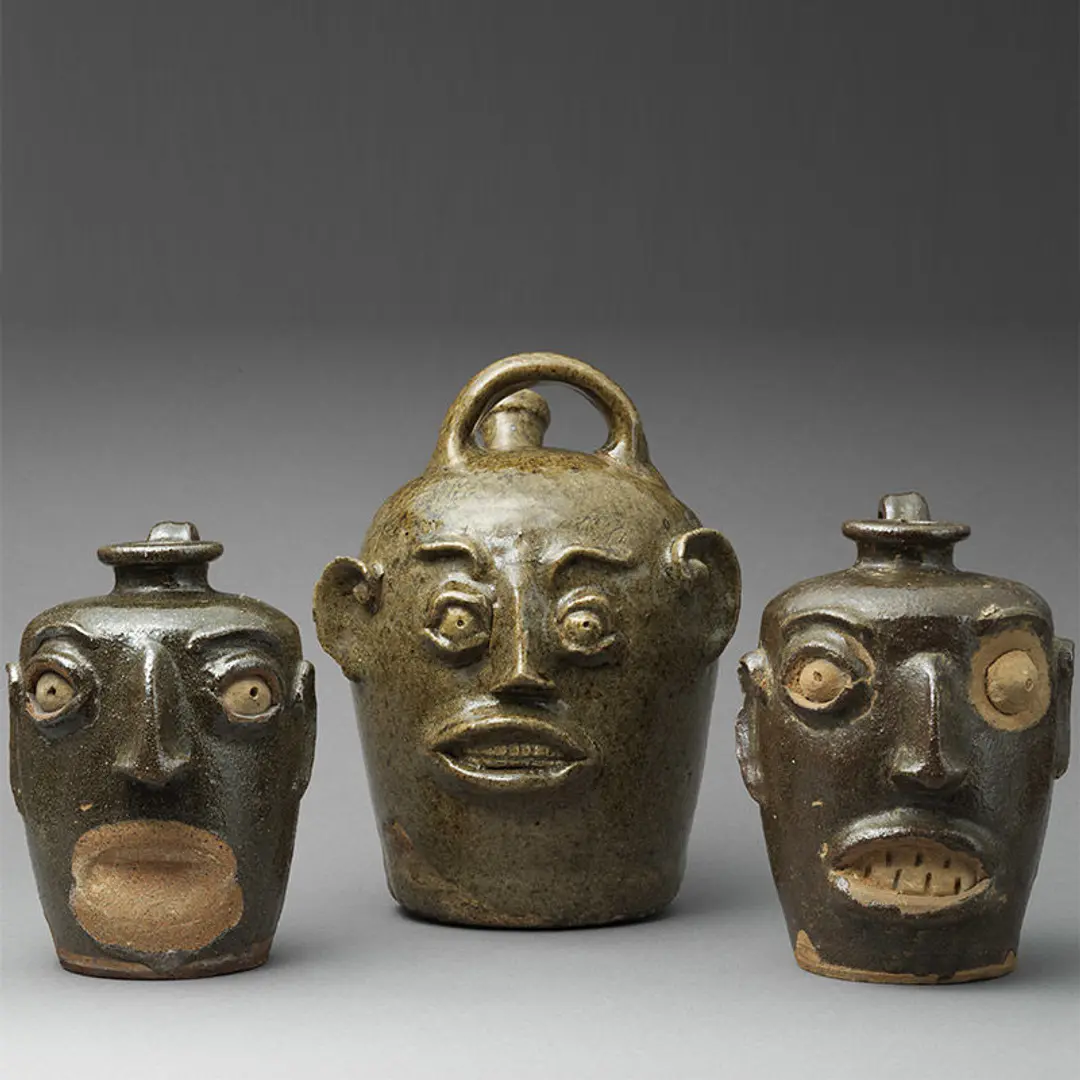
Face Vessels
NARRATOR: You’re looking at a selection of face jugs. Edgefield historian Wayne O’Bryant has traced their origin to the mid-19th century: from an illegal shipment of enslaved Africans.
WAYNE O’BRYANT: The transatlantic slave trade was outlawed in 1808. But in 1858, a man by the name of Charles Lamar purchased a ship called the Wanderer. So, he went over to the Kongo area and took onboard a little over 400 Africans. But when he landed on the coast of Georgia, since the authorities had already gotten wind of what he was doing, he put about 170-something on a boat, sent them up the Savannah River, and they landed in what was then Edgefield County. Some of them were put to work in the potteries. And so the face jugs began to pop up in the Edgefield County area around the same time. So that’s where the connections begin to start.
NARRATOR: But why jugs with faces on them? O’Bryant has his suspicions.
WAYNE O’BRYANT: When I was growing up in Charleston, there were actual legitimate drugstores that had backrooms that sold ritualistic vessels that were used in these conjures. They called it “putting root on somebody.” [laugh] And so when I first started seeing face jugs, it was more curiosity of what could they have used these for, and then it became more of, “I wonder if they’re used in the same way.”
NARRATOR: Another connection may be found in the wooden figure on view nearby.
It’s a power figure from the Wanderer survivors’ homeland, Kongo. To summon the spirit living within, an nganga, or ritual expert, would insert kaolin clay—coincidentally, the same clay the Wanderers found in Edgefield.
WAYNE O’BRYANT: They would have recognized that immediately. It must have been almost a source of joy for them to see that kaolin (Laughs) and in abundance like that.
I don’t think the Wanderer survivors that were sent other places made face jugs. That group that ended in Edgefield County, where they were making pottery, and they had the activating material, all kind of came together, and that’s why you didn’t see these pots all over the place.
- Simone-Leigh
-

Simone Leigh
TONYA MATTHEWS: I am a fan of modern artists who do a little shout out and then put their own twist on it. And so I think what Simone Leigh is doing with the face jugs is really, really interesting.
NARRATOR: Simone Leigh took inspiration from Dave Drake’s pots, and others like the nearby nineteenth-century face jug. But Leigh’s large Jug monumentalizes the object, stripping it of its function, as a vessel, while showing great fidelity to the overall form and proportions of the spout and handle.
In a recent interview, Leigh said that upon seeing Dave’s pots she felt compelled to feel the walls–one hand inside and one hand outside–to understand how he had thrown the work. For her it was a way to commune with the potter.
Dr. Tonya Matthews, President and CEO of the International African American Museum in Charleston, admires art that’s in conversation with the past.
One element Leigh adds, not seen in Edgefield but familiar in African cultures, are cowrie shells.
TONYA MATTHEWS: You’re looking at cowrie shells in the places where perhaps eyes and noses used to be. It almost looks like a face; ooh, but then again, if you know cowrie shells were also used as currency — it now starts to look like money. And so are we talking about the monetization of this work?
In addition, this piece is white. Now, there is white as in the clay markings that Africans use ceremonially to decorate their faces. And so if you are in a mode of reclaiming, you can really lean into the pride. But then in the African American context, we’re also talking about whitewashing, right? Art is always a conversation between the artist and whatever individual is interacting with the art.
- Adebunmi-Gbadebo
-
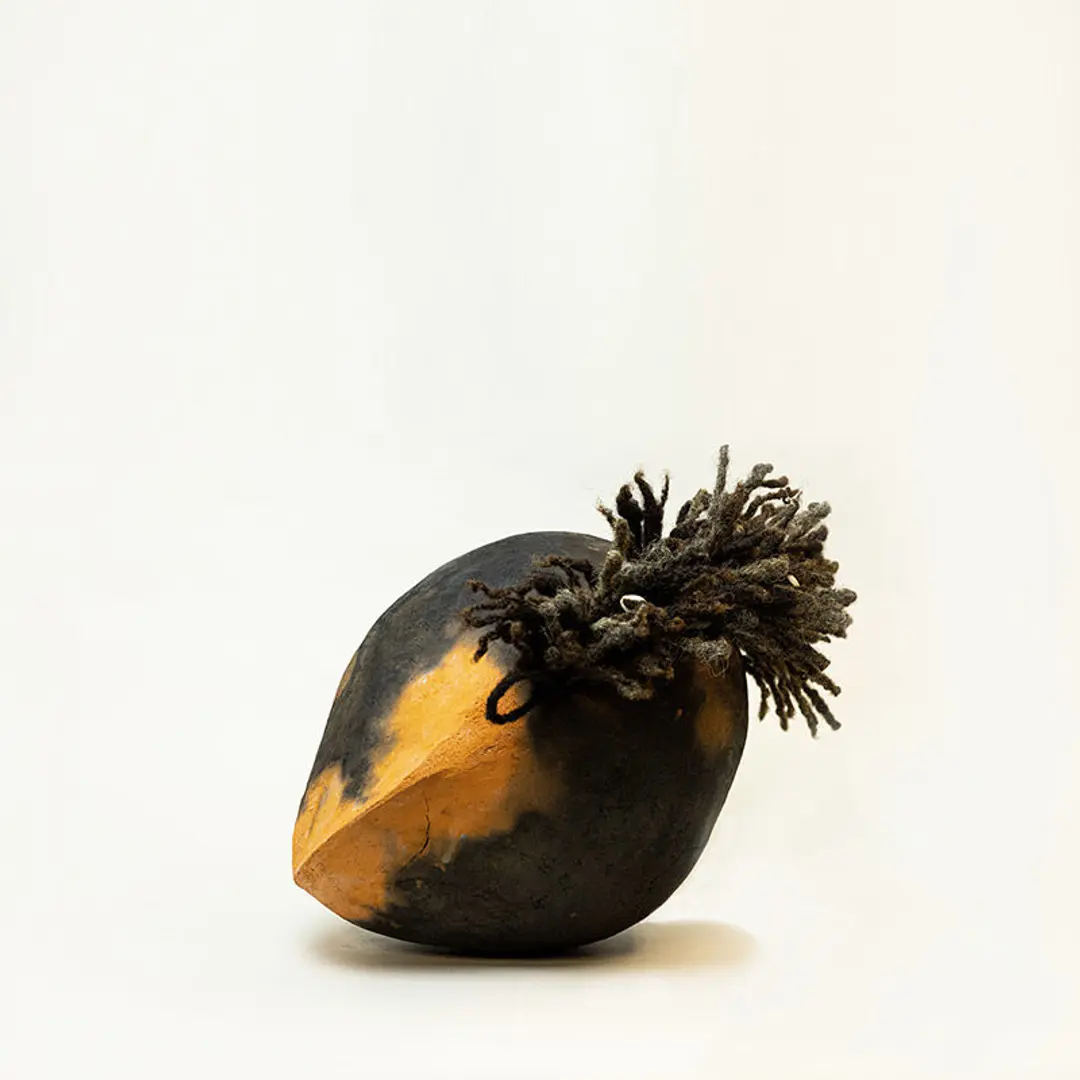
Adebunmi Gbadebo
ADEBUNMI GBADEBO: My name is Adebunmi Gbadebo, and I’m a visual artist working between Newark, New Jersey and Philadelphia.
“K.S.” is the inscription that is carved into one of the headstones on True Blue Cemetery in Fort Motte, South Carolina. Our family was enslaved on True Blue Plantation. The headstones in this cemetery are the only things that carry this acknowledgement of my ancestors.
In 2020, I made a trip to South Carolina to the cemetery. And I had that first idea: Can I make work from the very land that my ancestors were enslaved on, and they’re currently buried?
The materials used to make K.S. are the actual physical soil that I dug up (Laughs) and brought back to my studio in Philadelphia and also the human hair of Aaron Wilson, Kelsey Jackson and Cheryl Person, who all donated their locks to me. Black hair that not only is literally from Black bodies; it is our body, it carries our DNA.
NARRATOR: Gbadebo’s second piece commemorates a relative, Pirecie [Percy] McCory. It's also made from clay made from the soil of True Blue Cemetery—but this time, she adds rice.
ADEBUNMI GBADEBO: It is that Carolina Gold grain, which was at one point South Carolina’s biggest cash crop. You know, it wasn’t cotton; it was rice.
Rice and indigo are not indigenous to Europe or North America, they’re indigenous to Asia and Africa. Enslavers went to specific African countries, like Sierra Leone and Guinea, where they had centuries of knowledge of working in indigo and rice. It’s not just the human manpower that these enslavers depended on; they depended on our centuries of history of working in these crops. It shows how we as African people carry history within our very bodies.
- Conclusion
-

Conclusion
[MUSIC/SOUND TRANSITION MIRRORING INTRODUCTION STOP]
DAVID MACK: I think the discoveries that we’re making about David Drake are still ongoing. I think we’re just breaking into, the beginning of his legacy and understanding, his world.
GLENN LIGON: There are lots of things about Edgefield pottery, Dave’s pots in particular, that we can't know. I think that artists are responding by making things that in some ways are about filling in those things we can't know. With new things, with new objects, with new thoughts about those objects.
VINCENT BROWN: I think I hear a message in this work that speaks to me across time. It's kind of an inside joke that the endurance that Black people had, their perseverance under extreme circumstances, is in some ways, our transcendence.
NARRATOR: Thank you for listening to this Audio Guide. For more information about the speakers and their work, please visit the exhibition website.
- bio
-
Brooke Bauer

Brooke Bauer is a citizen of the Catawba Nation of South Carolina and an assistant professor of US history at the University of Tennessee Knoxville. She learned to make pottery and baskets from a long line of Catawba women, including her mother, grandmothers, and aunts. Bauer is also the author of Becoming Catawba: Catawba Indian Women and Nation-Building, 1540–1840 (2022). Other publications include an article on Catawba Indians in the Oxford Research Encyclopedia of American History and contributions to chapters in We Will Always Be Here: Native Peoples on Living and Thriving in the South (2016) and The Ethics of Anthropology and Amerindian Research: Reporting on Environmental Degradation and Warfare (2011).
Vincent Brown

Vincent Brown is the Charles Warren Professor of American History and Professor of African and African American Studies at Harvard University. He has published two prize-winning books about the history of slavery: Tacky’s Revolt: The Story of an Atlantic Slave War (2020) and The Reaper’s Garden: Death and Power in the World of Atlantic Slavery (2008). The author of numerous articles and reviews in scholarly journals, he is also principal investigator and curator for the animated thematic map Slave Revolt in Jamaica, 1760–1761: A Cartographic Narrative (2013). He produced the award-winning television documentary Herskovits at the Heart of Blackness (2009) and is the executive producer and host for The Bigger Picture, coproduced with WNET for PBS Digital.
George W. Calfas
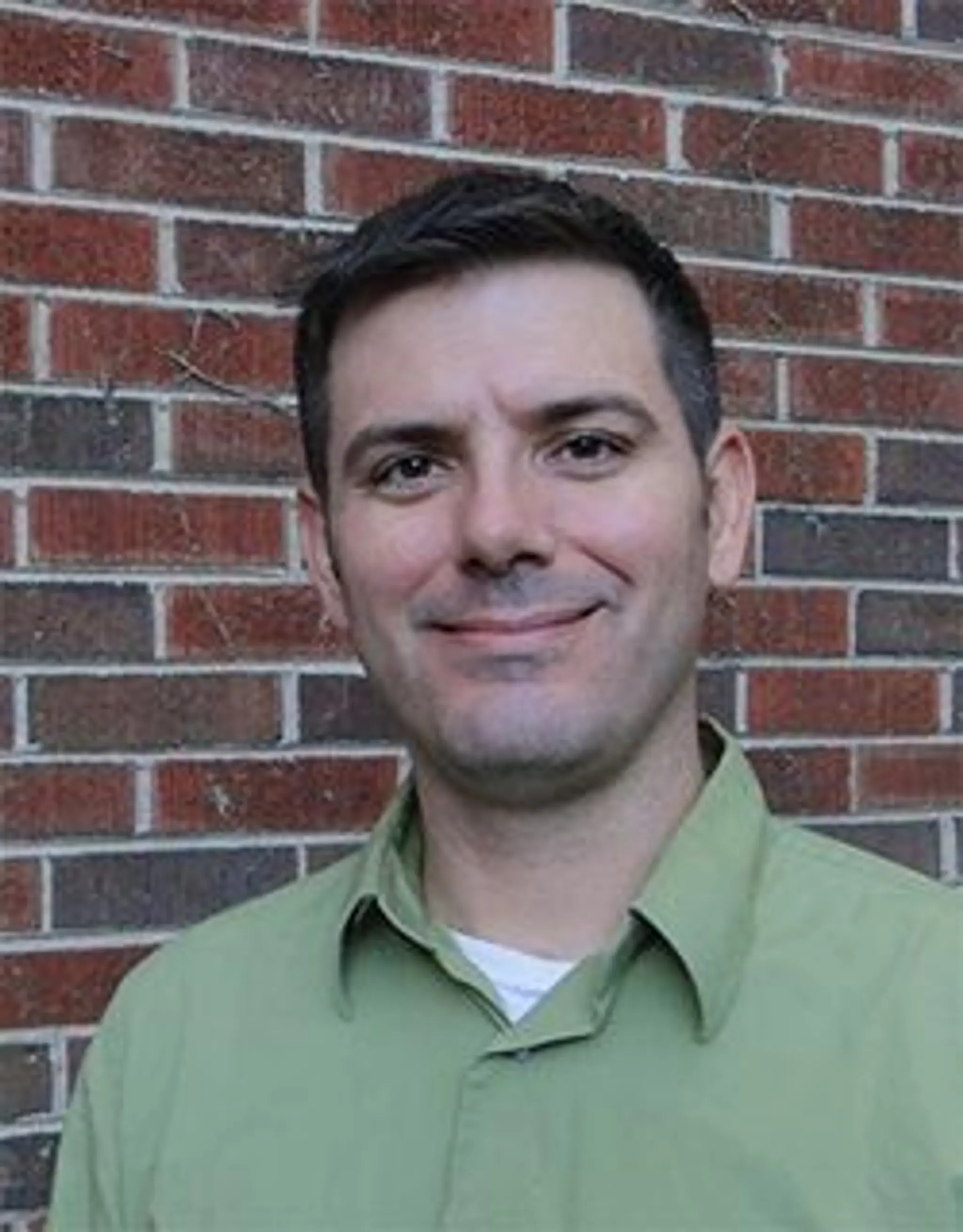
George W. Calfas is an archaeologist and holds a PhD in anthropology and archaeology from the University of Illinois at Urbana-Champaign. He is an active member of the Register of Professional Archaeologists, Society for American Archaeology, and Society for Historical Archaeology. He is also an adjunct professor in the Department of Anthropology at the University of Illinois at Urbana-Champaign and advises doctoral candidates in the departments of anthropology, sociology, engineering, and regional and urban planning. His research interests focus on aspects of African diaspora cultures and history and the development of stoneware ceramic traditions by African American and European American craftspeople. Currently, George serves as a co-project investigator for graduate research at the National Historic Landmark site of New Philadelphia in Pike County, Illinois.
Adebunmi Gbadebo

Adebunmi Gbadebo is an artist whose work centers on deeply resonant materials like indigo, clay hand dug from plantations, and human hair. She creates her work through intensive research, site visits, and material investigations that inform her studio practice. Her work carefully tends to the stories of ancestors, families, and individuals either long overlooked or too-closely surveilled. New Jersey–born and Philadelphia-based Adebunmi earned her BFA at the School of Visual Arts in New York City. Her work is in the collections of the Smithsonian National Museum of African Art, Smithsonian National Museum of African American History and Culture, Minneapolis Institute of Art, Museum of Fine Arts, Boston, South Carolina State Museum, and Newark Museum of Art, among others.
Glenn Ligon
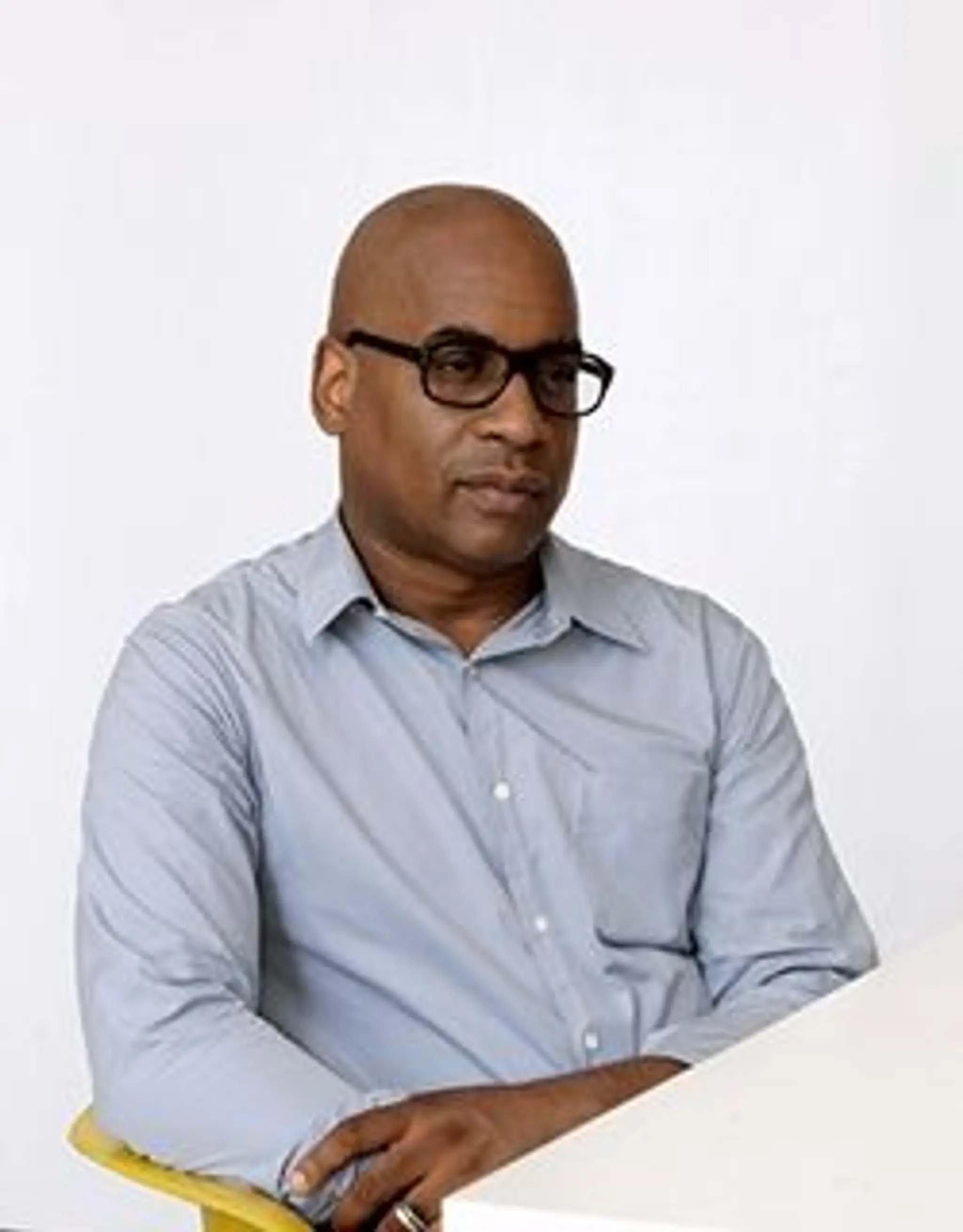
Glenn Ligon is an artist living and working in New York. Throughout his career, Ligon has pursued an incisive exploration of American history, literature, and society across bodies of work that build critically on the legacies of modern painting and conceptual art. He received a BA from Wesleyan University and attended the Whitney Museum Independent Study Program. In 2011, the Whitney Museum of American Art held a midcareer retrospective of Ligon’s work, Glenn Ligon: America, which traveled nationally. Important recent shows include Grief and Grievance (2021) at the New Museum, where Ligon acted as a curatorial advisor; Des Parisiens Noirs at the Musée d’Orsay, Paris; Blue Black (2017), an exhibition Ligon curated at the Pulitzer Arts Foundation in St. Louis; and Glenn Ligon: Encounters and Collisions (2015), a curatorial project organized with Nottingham Contemporary and Tate Liverpool.
David Mack

David F. Mack is an artist, educator, researcher, and retired Lieutenant Colonel. He received his BS from Morgan State University, an MFA from the Maryland Institute College of Art, and an advanced military diploma from the US Army Command and General Staff College. He received three National Council on Education for the Ceramic Arts (NCECA) program acceptance proposal letters and was a 2021 NCECA virtual panel member for the discussion group Enslaved and Freed Nineteenth Century African American Potters. He also contributes to Ceramics Monthly magazine, with his most recent article being “Enslaved and Freed African-American Potters” (2020), and is the author of a reparations proposal titled The Stolen Bones Act of 1619, which would return stolen artifacts made by industrial enslaved people to their descendants.
Tonya M. Matthews

Tonya M. Matthews is president and CEO of the International African American Museum (IAAM), located in Charleston, South Carolina. As a champion of authentic, empathetic storytelling of American history, IAAM is one of the nation’s newest platforms for the disruption of institutionalized racism. A thought leader in inclusive frameworks, social entrepreneurship, and education, Matthews has written articles and book chapters across these varied subjects. She is the founder of The STEMinista Project, a movement to engage girls in their future with STEM careers. She is also a poet and is included in The 100 Best African American Poems: A Black Poetry Collection (2010), edited by Nikki Giovanni. She received her PhD in biomedical engineering from Johns Hopkins University and her BSE in engineering from Duke University alongside a certificate in African/African American studies.
Wayne O’Bryant

Wayne O’Bryant is an award-winning author, historian, lecturer, and researcher. Wayne has written several books on African American history and comparative religions. He has been featured in several documentaries on African American history, serves as a consultant to multiple museums, and curates exhibitions on African American culture across the United States. Born in Charleston, South Carolina, the premier slave port for the US transatlantic slave trade, he was raised by three generations of master educators who taught among the enigmatic Gullah Geechee people. His maternal relatives taught him Black history that was missing from textbooks, laying the foundation for his understanding of America and its relation to African American history. He later moved to North Augusta, South Carolina, where his paternal ancestry stretches back to the mid-1700s in Old Edgefield County. Some of his enslaved ancestors worked in the potteries with Dave (later known as David Drake) and were present when a new group of Africans arrived on the slave ship Wanderer.
